Lingyun Xu
CrayonRobo: Object-Centric Prompt-Driven Vision-Language-Action Model for Robotic Manipulation
May 04, 2025Abstract:In robotic, task goals can be conveyed through various modalities, such as language, goal images, and goal videos. However, natural language can be ambiguous, while images or videos may offer overly detailed specifications. To tackle these challenges, we introduce CrayonRobo that leverages comprehensive multi-modal prompts that explicitly convey both low-level actions and high-level planning in a simple manner. Specifically, for each key-frame in the task sequence, our method allows for manual or automatic generation of simple and expressive 2D visual prompts overlaid on RGB images. These prompts represent the required task goals, such as the end-effector pose and the desired movement direction after contact. We develop a training strategy that enables the model to interpret these visual-language prompts and predict the corresponding contact poses and movement directions in SE(3) space. Furthermore, by sequentially executing all key-frame steps, the model can complete long-horizon tasks. This approach not only helps the model explicitly understand the task objectives but also enhances its robustness on unseen tasks by providing easily interpretable prompts. We evaluate our method in both simulated and real-world environments, demonstrating its robust manipulation capabilities.
SoFar: Language-Grounded Orientation Bridges Spatial Reasoning and Object Manipulation
Feb 18, 2025



Abstract:Spatial intelligence is a critical component of embodied AI, promoting robots to understand and interact with their environments. While recent advances have enhanced the ability of VLMs to perceive object locations and positional relationships, they still lack the capability to precisely understand object orientations-a key requirement for tasks involving fine-grained manipulations. Addressing this limitation not only requires geometric reasoning but also an expressive and intuitive way to represent orientation. In this context, we propose that natural language offers a more flexible representation space than canonical frames, making it particularly suitable for instruction-following robotic systems. In this paper, we introduce the concept of semantic orientation, which defines object orientations using natural language in a reference-frame-free manner (e.g., the ''plug-in'' direction of a USB or the ''handle'' direction of a knife). To support this, we construct OrienText300K, a large-scale dataset of 3D models annotated with semantic orientations that link geometric understanding to functional semantics. By integrating semantic orientation into a VLM system, we enable robots to generate manipulation actions with both positional and orientational constraints. Extensive experiments in simulation and real world demonstrate that our approach significantly enhances robotic manipulation capabilities, e.g., 48.7% accuracy on Open6DOR and 74.9% accuracy on SIMPLER.
Synergizing Covert Transmission and mmWave ISAC for Secure IoT Systems
Feb 17, 2025



Abstract:This work focuses on the synergy of physical layer covert transmission and millimeter wave (mmWave) integrated sensing and communication (ISAC) to improve the performance, and enable secure internet of things (IoT) systems. Specifically, we employ a physical layer covert transmission as a prism, which can achieve simultaneously transmitting confidential signals to a covert communication user equipment (UE) in the presence of a warden and regular communication UEs. We design the transmit beamforming to guarantee information transmission security, communication quality-of-service (QoS) and sensing accuracy. By considering two different beamforming architectures, i.e., fully digital beamforming (FDBF) and hybrid beamforming (HBF), an optimal design method and a low-cost beamforming scheme are proposed to address the corresponding problems, respectively. Numerical simulations validate the effectiveness and superiority of the proposed FDBF/HBF algorithms compared with traditional algorithms in terms of information transmission security, communication QoS and target detection performance.
Exploiting Target Location Distribution in MIMO Radar: PCRB vs. PSBP for Waveform Design
Jul 27, 2024



Abstract:This paper investigates the issue of how to exploit target location distribution for multiple input multiple output (MIMO) radar waveform design. We consider a MIMO radar aiming to estimate the unknown and random angular location parameters of a point target, whose distribution information can be exploited by the radar. First, we establish the models of the MIMO radar system and the target location distribution. Based on the considered models, we propose the first category of target location distribution exploitation methods by analyzing the radar direction-of-angle (DoA) estimation performance and deriving a general form of posterior Cramer-Rao bound (PCRB) as the lower bound of the mean square error of DoA estimation. Following this, to explore more insights, we proposed the second category of target location distribution exploitation methods by introducing a novel radar metric, probability scaled beampattern (PSBP), from the perspective of radar beampattern. To compare the two methods, we formulate the PCRB and PSBP oriented radar waveform design problems and propose corresponding low-complexity and convergence-guaranteed algorithms to tackle them. Finally, numerical simulations are conducted in different scenarios to provide a comprehensive evaluation and comparison of the radar performance.
General Place Recognition Survey: Towards Real-World Autonomy
May 08, 2024



Abstract:In the realm of robotics, the quest for achieving real-world autonomy, capable of executing large-scale and long-term operations, has positioned place recognition (PR) as a cornerstone technology. Despite the PR community's remarkable strides over the past two decades, garnering attention from fields like computer vision and robotics, the development of PR methods that sufficiently support real-world robotic systems remains a challenge. This paper aims to bridge this gap by highlighting the crucial role of PR within the framework of Simultaneous Localization and Mapping (SLAM) 2.0. This new phase in robotic navigation calls for scalable, adaptable, and efficient PR solutions by integrating advanced artificial intelligence (AI) technologies. For this goal, we provide a comprehensive review of the current state-of-the-art (SOTA) advancements in PR, alongside the remaining challenges, and underscore its broad applications in robotics. This paper begins with an exploration of PR's formulation and key research challenges. We extensively review literature, focusing on related methods on place representation and solutions to various PR challenges. Applications showcasing PR's potential in robotics, key PR datasets, and open-source libraries are discussed. We also emphasizes our open-source package, aimed at new development and benchmark for general PR. We conclude with a discussion on PR's future directions, accompanied by a summary of the literature covered and access to our open-source library, available to the robotics community at: https://github.com/MetaSLAM/GPRS.
Task-Oriented Hybrid Beamforming for OFDM-DFRC Systems with Flexibly Controlled Space-Frequency Spectra
Mar 18, 2024

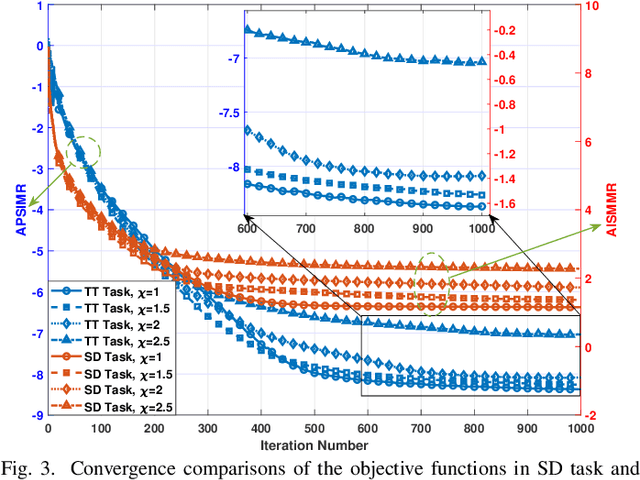
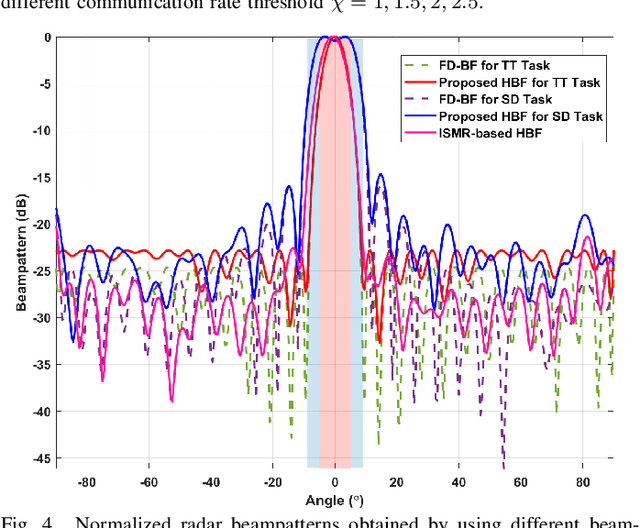
Abstract:This paper investigates the issues of the hybrid beamforming design for the orthogonal frequency division multiplexing dual-function radar-communication (DFRC) system in multiple task scenarios involving the radar scanning and detection task and the target tracking task. To meet different task requirements of the DFRC system, we introduce two novel radar beampattern metrics, the average integrated sidelobe to minimum mainlobe ratio (AISMMR) and average peak sidelobe to integrated mainlobe ratio (APSIMR), to characterize the space-frequency spectra in different scenarios. Then, two HBF design problems are formulated for two task scenarios by minimizing the AISMMR and APSIMR respectively subject to the constraints of communication quality-of-service (QoS), power budget, and hardware. Due to the non-linearity and close coupling between the analog and digital beamformers in both the objective functions and QoS constraint, the resultant formulated problems are challenging to solve. Towards that end, a unified optimization algorithm based on a consensus alternating direction method of multipliers (CADMM) is proposed to solve these two problems. Moreover, under the unified CADMM framework, the closed-form solutions of primal variables in the original two problems are obtained with low complexity. Numerical simulations are provided to demonstrate the feasibility and effectiveness of the proposed algorithm.
Enhancing Physical Layer Security in Dual-Function Radar-Communication Systems with Hybrid Beamforming Architecture
Mar 12, 2024


Abstract:In this letter, we investigate enhancing the physical layer security (PLS) for the dual-function radar-communication (DFRC) system with hybrid beamforming (HBF) architecture, where the base station (BS) achieves downlink communication and radar target detection simultaneously. We consider an eavesdropper intercepting the information transmitted from the BS to the downlink communication users with imperfectly known channel state information. Additionally, the location of the radar target is also imperfectly known by the BS. To enhance PLS in the considered DFRC system, we propose a novel HBF architecture, which introduces a new integrated sensing and security (I2S) symbol. The secure HBF design problem for DFRC is formulated by maximizing the minimum legitimate user communication rate subject to radar interference-plus-noise ratio, eavesdropping rate, hardware and power constraints. To solve this non-convex problem, we propose an alternating optimization based method to jointly optimize transmit and receive beamformers. Numerical simulation results validate the effectiveness of the proposed algorithm and show the superiority of the proposed I2S-aided HBF architecture for achieving DFRC and enhancing PLS.
Temporal Point Cloud Completion with Pose Disturbance
Feb 07, 2022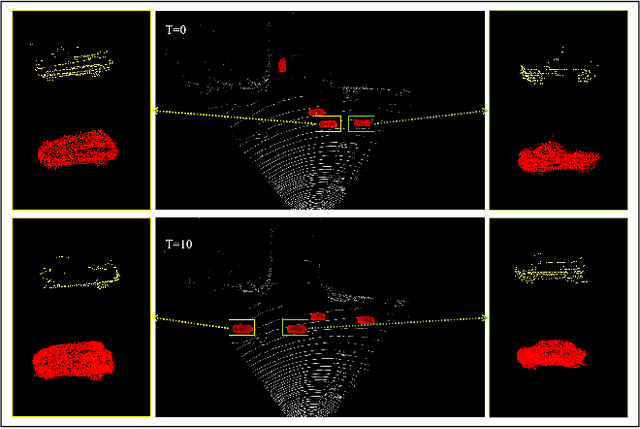

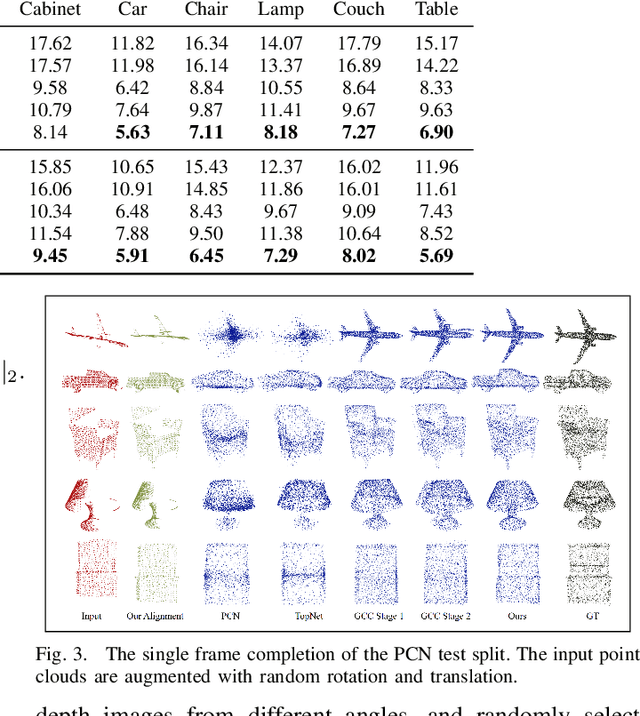
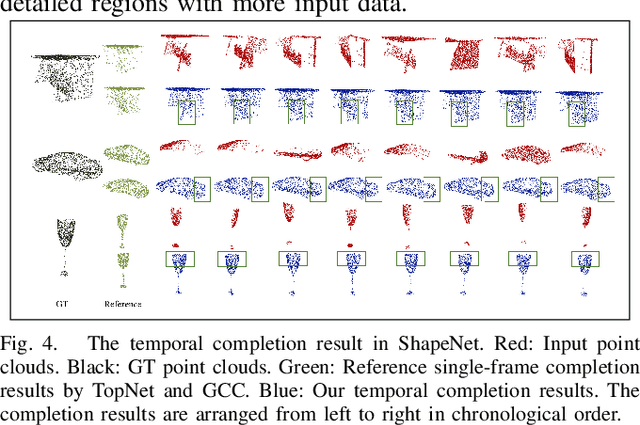
Abstract:Point clouds collected by real-world sensors are always unaligned and sparse, which makes it hard to reconstruct the complete shape of object from a single frame of data. In this work, we manage to provide complete point clouds from sparse input with pose disturbance by limited translation and rotation. We also use temporal information to enhance the completion model, refining the output with a sequence of inputs. With the help of gated recovery units(GRU) and attention mechanisms as temporal units, we propose a point cloud completion framework that accepts a sequence of unaligned and sparse inputs, and outputs consistent and aligned point clouds. Our network performs in an online manner and presents a refined point cloud for each frame, which enables it to be integrated into any SLAM or reconstruction pipeline. As far as we know, our framework is the first to utilize temporal information and ensure temporal consistency with limited transformation. Through experiments in ShapeNet and KITTI, we prove that our framework is effective in both synthetic and real-world datasets.
Graph-Guided Deformation for Point Cloud Completion
Nov 11, 2021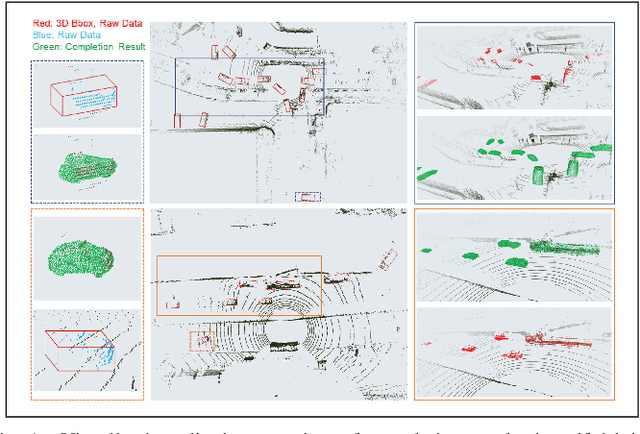


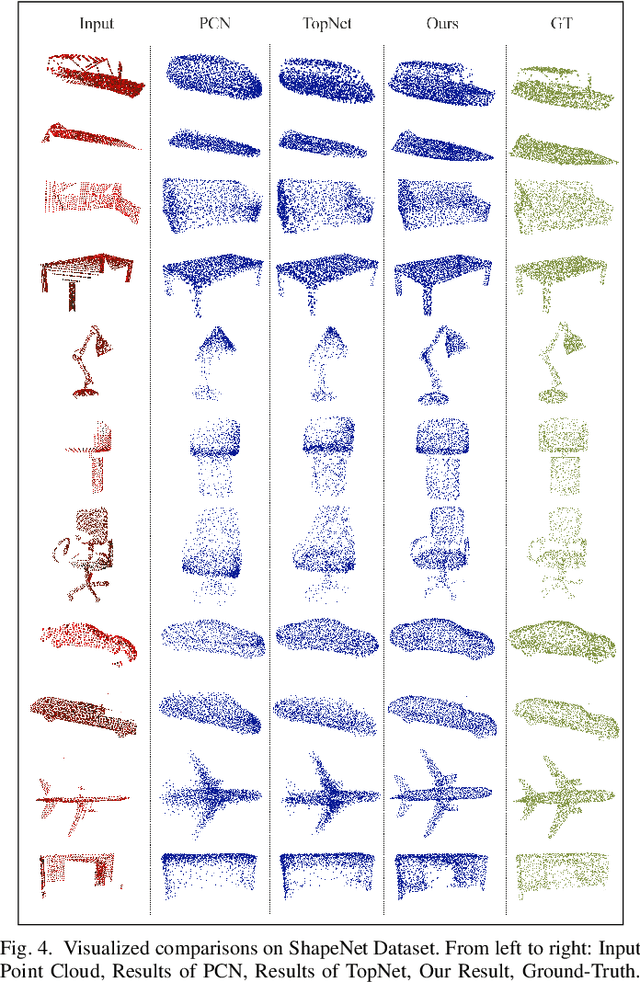
Abstract:For a long time, the point cloud completion task has been regarded as a pure generation task. After obtaining the global shape code through the encoder, a complete point cloud is generated using the shape priorly learnt by the networks. However, such models are undesirably biased towards prior average objects and inherently limited to fit geometry details. In this paper, we propose a Graph-Guided Deformation Network, which respectively regards the input data and intermediate generation as controlling and supporting points, and models the optimization guided by a graph convolutional network(GCN) for the point cloud completion task. Our key insight is to simulate the least square Laplacian deformation process via mesh deformation methods, which brings adaptivity for modeling variation in geometry details. By this means, we also reduce the gap between the completion task and the mesh deformation algorithms. As far as we know, we are the first to refine the point cloud completion task by mimicing traditional graphics algorithms with GCN-guided deformation. We have conducted extensive experiments on both the simulated indoor dataset ShapeNet, outdoor dataset KITTI, and our self-collected autonomous driving dataset Pandar40. The results show that our method outperforms the existing state-of-the-art algorithms in the 3D point cloud completion task.
PSE-Match: A Viewpoint-free Place Recognition Method with Parallel Semantic Embedding
Aug 01, 2021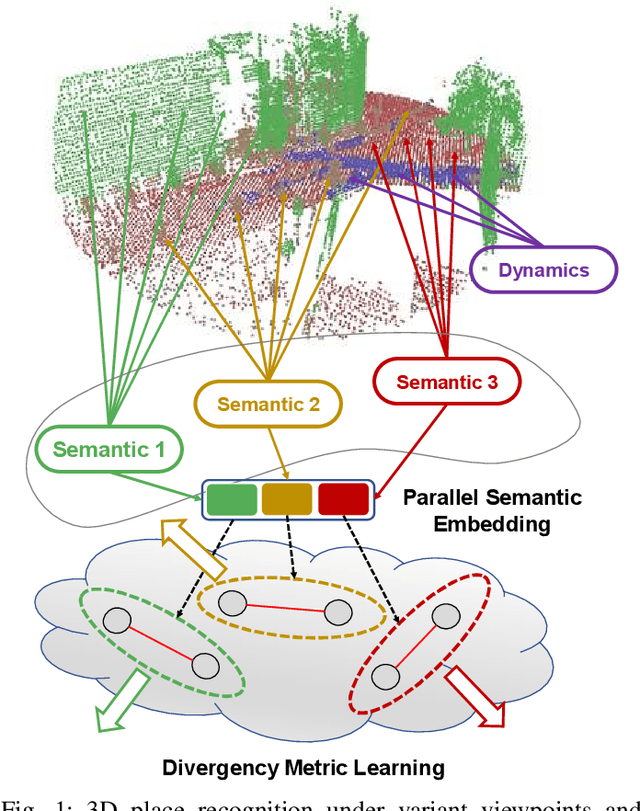
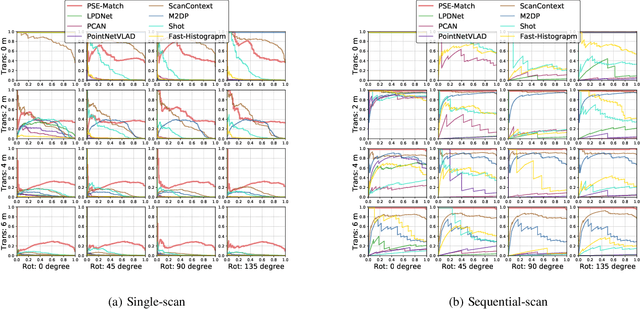
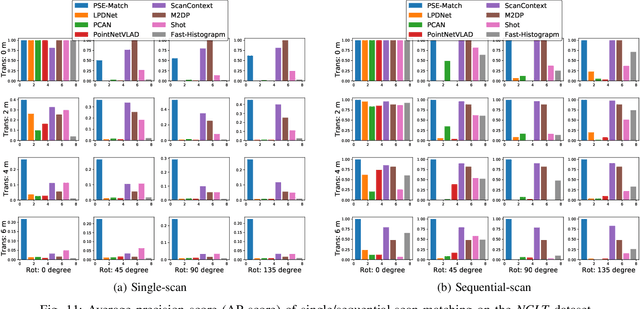
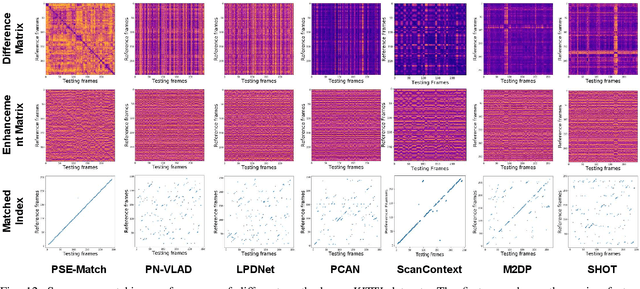
Abstract:Accurate localization on autonomous driving cars is essential for autonomy and driving safety, especially for complex urban streets and search-and-rescue subterranean environments where high-accurate GPS is not available. However current odometry estimation may introduce the drifting problems in long-term navigation without robust global localization. The main challenges involve scene divergence under the interference of dynamic environments and effective perception of observation and object layout variance from different viewpoints. To tackle these challenges, we present PSE-Match, a viewpoint-free place recognition method based on parallel semantic analysis of isolated semantic attributes from 3D point-cloud models. Compared with the original point cloud, the observed variance of semantic attributes is smaller. PSE-Match incorporates a divergence place learning network to capture different semantic attributes parallelly through the spherical harmonics domain. Using both existing benchmark datasets and two in-field collected datasets, our experiments show that the proposed method achieves above 70% average recall with top one retrieval and above 95% average recall with top ten retrieval cases. And PSE-Match has also demonstrated an obvious generalization ability with a limited training dataset.
 Add to Chrome
Add to Chrome Add to Firefox
Add to Firefox Add to Edge
Add to Edge